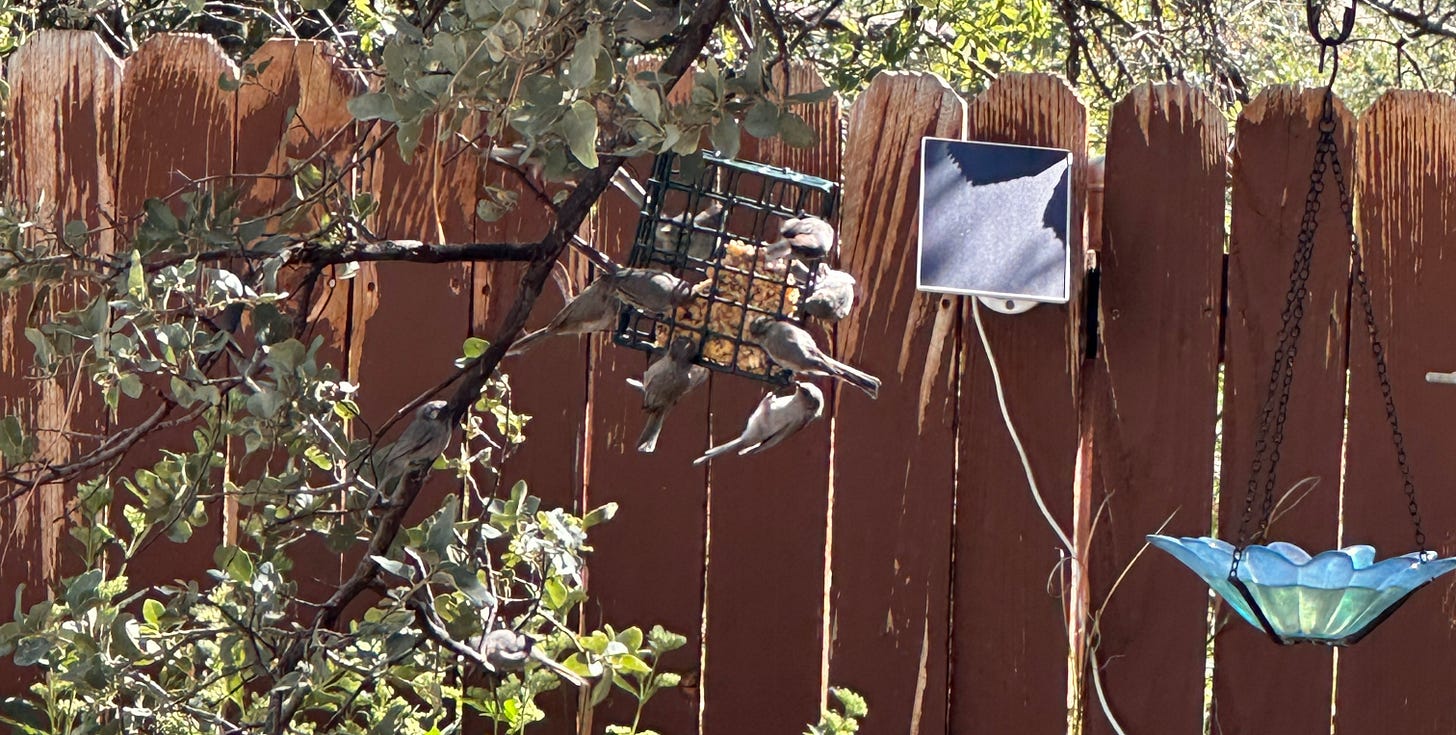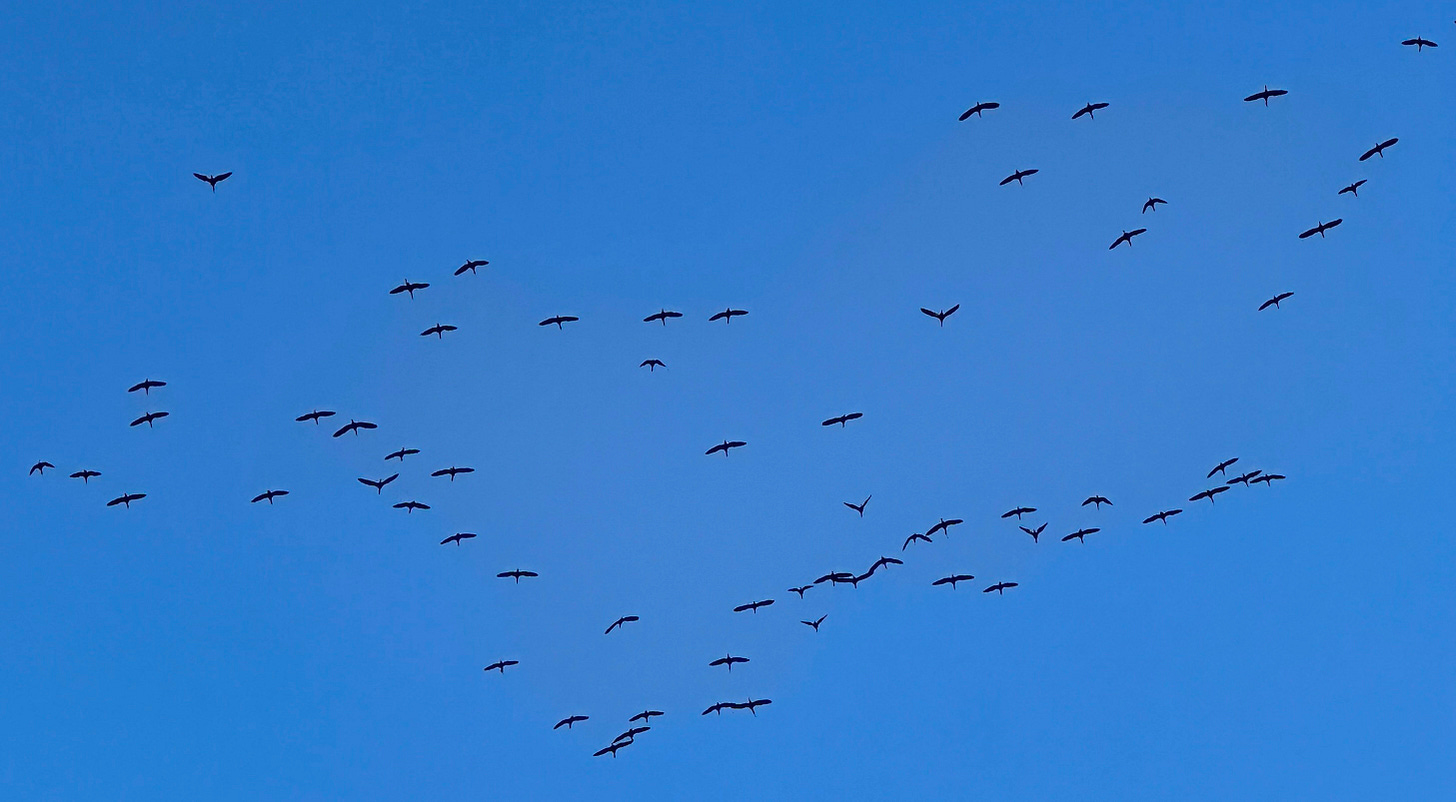The turn from summer to fall has a specific texture in the human world, associated with many idiosyncratic practices. We order pumpkin spice lattes, bake apple pies, roast butternut squash. We barricade ourselves in cozy fortresses of turtleneck sweaters and woodsy candles, staving off seasonal depression as the days grow shorter and darker. We assemble overly-clever Halloween costumes, crunch leaves under Doc Marten boots, and dive into ill-advised relationships, if only to have a warm body to hold through the winter. We consider seeking out a new therapist. You know the cliches.
Life in bird society changes, too, at this seasonal juncture, in even more profound, elemental ways. While we tend to our mental health to brace for months of cold and darkness, the birds’ task is to shore up their physical health to withstand the challenges of winter.
The spring and summer were seasons of courtship, breeding, nesting, and rearing young. For most birds, these activities demand staking out a territory and defending it with everything they have. Breeding males get so hopped up on their raging hormones, they literally cannot tolerate another male’s presence in their territory, lest this cheeky interloper fertilize some of his mate’s eggs. This territoriality ensures that each breeding pair – or collective, in the case of peculiar species like acorn woodpeckers – lays claim to enough resources to develop their young into healthy juveniles. Territorial vigilance, moreover, helps birds defend the nest from the relentless threats of predation by raccoons, snakes, weasels, foxes, bobcats, other birds, and many more animals that would love nothing more than an easy nestling snack or a tasty egg.
But come fall, breeding hormones have subsided and the surviving juveniles have grown as large as the adults who raised them, distinguished, if at all, only by differences in their plumage. The focus of bird society shifts from the survival of each breeding pair’s young to the survival of the collective through the cold temperatures and food scarcity of the coming winter. Birds who would have fought to the death had they encountered each other during breeding season now reunite, to undertake migrations towards the equator to their warmer wintering grounds, to gorge collectively on the bounties of the harvest season, or to cache resources to sustain themselves through the winter.

Back in July, I wrote about my summer birding escapades in Watson Woods, where I became familiar with numerous birds and bird pairs that were always present and visible in their chosen territory – depending on the species’ size and foraging habits, this territory could be as small as a few square yards or as large as the entire 128 acre woodland. But when I returned to Watson Woods for a bird walk one evening a few weeks ago, none of these birds were posted up as they had been throughout the summer. They have simply moved on.
Birding in the fall is characterized instead by fantastic assemblages of birds collectively migrating and foraging, taking advantage of the safety that can be found in large numbers. Watson Lake, the reservoir adjacent to Watson Woods, is now a frenzy of activity that grows with each passing day. The lake is a popular over-wintering spot for many species of waterfowl, some of whom have begun to arrive and assemble in large flocks. Other migratory birds stop over at the lake for days or weeks, enjoying the bounties of insects, seeds, and berries this riparian area has to offer, which will power them through the rest of their journey south.
In late July, while putting around Watson Lake in a kayak, I spotted the first white-faced ibis I’d ever seen there plumbing the banks with his long, curved bill. Throughout August, more and more migrating ibises arrived, and in early September, my friend and I watched over 100 of these ibises take flight off the lake, circling it in the air and amassing into a swirling flock that eventually departed southbound to Mexico. While I miss the pairs Say’s Phoebes, Blue Grosbeaks, and Cooper’s Hawks I got to know each visit to Watson Woods throughout the summer, these collective spectacles are unique to the migration season and fill me with awe. It’s a privilege to witness these great cycles of nature that move millions and millions of birds back and forth across continents and oceans every year.
It’s thrilling this time of year to have chance encounters with species who have traveled vast distances from their breeding grounds, who have many hundreds or thousands of miles more to travel to their winter homes. During a recent outing on Mingus Mountain with local birding legend and owner of The Lookout Eric Moore, in a matter of minutes, we encountered an Olive-sided Flycatcher en route from the boreal forests of Canada to Colombia, and a Swainson’s Hawk on its way from the Great Basin grasslands to its summer home all the way in Argentina.
I traveled far and wide this North American summer, from British Columbia to central Florida, and encountered 70-some-odd bird species that were new to my life list, species I would never or only rarely find in Prescott. I won’t soon forget coming face to face with a Great Horned Owl at Tule Lake Wildlife Refuge, paddling alongside a pair of Green Herons on the Rainbow River, or watching a flock of enormous American White Pelicans soar over farmland hundreds of miles inland on the California-Oregon border. And yet, as much as I love learning new species and growing my life list, nothing makes me feel more grounded and connected to the movements of nature than watching the birds at my backyard feeders and on my neighborhood trails.
My backyard is a bird-rich as it has ever been right now — many species who were focused on hunting insects during the summer are now taking a greater interest in the seeds at my feeder, rich in healthy fats that will keep them warm in the winter. Just in the days I’ve been writing this article, the green-tailed towhees and white crowned sparrows who winter in Prescott have arrived in my yard, and year-round resident Bewick’s wrens and dark-eyed juncos have used my feeders for the first time.
The non-migratory birds that will stay here through the snowy winter — the woodpeckers, jays, titmice, and chickadees, to name a few — are in full-blown caching mode. The omnipresent acorn woodpeckers and the scrub jays are focused on the ripening acorn crop. The woodpeckers take their acorns to the colony’s designated granary tree, which can be an old snag, a living pine, a telephone pole, or the side of your house — anything they can drill deep into. These granaries contain thousands of collectively maintained, acorn-sized holes, which are filled each fall and stringently defended from thieving squirrels and chipmunks. This time of year, I like to watch my neighborhood acorn woodpecker colony’s progress on their enormous Ponderosa Pine granary.

Scrub jays, on the other hand, cache their acorns directly in the ground all over the place, using their remarkable corvid brains to keep track of thousands of individual acorns. But of course, some of these acorns are inevitably forgotten, which is fortuitous for the acorns – they find themselves lodged at an ideal depth in the soil where they can germinate into new oak trees. And so, the jays are really the sowers of all these trees, the architects of these oak woodlands that feed them and so many other species throughout the fall and winter. I probably have a jay to thank for the sturdy oak whose branches support all my bird feeders and provide a playground for sorts of avian, mammalian, and reptilian backyard visitors.
My obsession with my backyard birds is so fanatical, a couple months ago I bought a PeckPerk, a feeder equipped with a motion-activated camera that streams live footage to my phone at all times and takes videos whenever it detects bird motion. It takes about 60-90 minutes of footage each day, and as obsessed as I am with my backyard birds, I do not, in fact, take the time to sift through all of these videos. But I scroll through the thumbnails often and watch the scenes that include birds I rarely see at the feeder or particularly heated disputes between house finches, of which there is never a shortage.
My PeckPerk would perhaps better be named the House Finch Cam – 95% of the videos it sends me are of these chatty, gregarious feeder birds who seem to spend every hour of every day eating my sunflower seeds and millet. But observing the subtleties of their expressions and the textures of their every feather up close has only further endeared me to these birds you just can’t get away from. The females may be dowdy, but they’re feisty and animated, and the males express a delightful range in the distribution and intensity of their rosy red face and chest patches. House finches are social birds par excellence, whose musical voices are constantly audible. The collective life is something that never really ceases for them, no matter the season, though it certainly intensifies outside of breeding times.
The videos my feeder captures betray the house finches’ cantankerous, irreverant nature, which perhaps is how they cope with the constant demands of living together. In the video below, a cherry-red male shoves his compatriot very dramatically off the feeder’s edge, with so little remorse, he doesn’t even stop chewing his seeds. Even though we can assume his fallen comrade took flight, the angle makes it appear as though he has plummeted to his demise. I laugh every time I watch it.
But it’s not all house finches. So far, at least 12 of the 27 birds I have observed in my backyard have been caught up-close on this feeder camera. To celebrate the changing of the seasons and the accompanying shifts in bird and human life, I’d like to introduce you to each of them with a video clip.
The Spotted Towhees avoided the feeders throughout the summer, preferring to forage on the ample ground insects that come alive in the monsoon rains and heat. But now that temperatures are dropping and many bugs have completed their annual life cycles, the towhees have begun to take more of an interest in seeds, including those at the feeder. In this close up, you can really see this large, long-tailed sparrow’s striking red eyes and spotted wings.
The Mountain Chickadees are so shy and stealthy, I didn’t know they were in my yard until I put up this feeder cam. They have undoubtedly been here all along, but they are so tiny and flighty, easily mistaken for a titmouse or bushtit or nuthatch at a glance. In this remarkable clip, a chickadee uses his aptitude for hanging upside down to hide from an approaching house finch like a secret agent, until he decides she is no mortal threat. He then grabs one single seed and flies away with it as is his custom, perhaps to enjoy it in the privacy of his own home, perhaps to store it for the coming winter. Bless his heart.
Putting up these feeder cams fortunately coincided with an influx of Black-headed Grosbeaks into my backyard in early August. This vibrant male could be mistaken for a Spotted Towhee based on color alone, but he has a much thicker, stouter beak, a shorter tail, and more rufous coloring throughout his body. Black-headed Grosbeaks are close relatives of Cardinals, and they will very soon head south to spend the winter in Mexico. Listen to this one whistle a happy song as he chows down.
Buntings are also relatives of Cardinals, and for a few delightful days in August, this male Lazuli Bunting and his mate visited my feeders. While he’s not in his full breeding plumage glory, many striking electric blue feathers are still mixed into the white and rufous. Behind him in this video, a confused female house finch wonders who this bluish fellow is monopolizing the feeder.
Testing the weight limit of the PeckPerk is this intrepid, adorable Mourning Dove, who typically forages on the ground. Watch the whole unit bounce as she descends. Something about their tiny heads and the bright white ring around their beady black eyes gives Mourning Doves a charming innocence, a happy and tranquil vacancy of expression.
Much to my chagrin, the Woodhouse Scrub Jays eat like their primary goal is to fling as much seed from the feeders as possible. A most impolite table guest, but what a beautiful blue color! You can see his charming white eyebrows really well in this closeup. This is another bird that has only starting coming to the feeders in the last few weeks, shifting from insect-hunting to seed-caching as their primary foraging strategy. On the upshot, the mess he makes does attract ground-feeders like towhees, doves, sparrows, chipmunks, and squirrels to hang out below the feeder.
The Ladder-backed Woodpecker is not a frequent seed feeder visitor, preferring the suet block and the hummingbird water. You can hear the power of his peck as he briefly tries to find what juicy bugs may lie inside the plastic feeder.
The Bridled Titmouse is the coolest little bird. So unbelievably suave. That hair-do! Those beautiful face markings! Unfortunately, he is also a grab-one-seed-and-run kind of feeder. These titmice are primarily a Mexican species, but in parts of Arizona and New Mexico, we are blessed with year-round residents.
This adorable, cautious Juniper Titmouse is very similar in appearance and demeanor to the Tufted Titmouse you see often in the eastern US. They are another year-round resident in Prescott that caches seed for the winter.
The White-breasted Nuthatch is a little bird with a honking woodpecker-like bill and fondness for walking up and down along tree trunks. Here we see a house finch acting in his self-appointed role of guardian of the feeder, scaring away the birds that I don’t already have 10,000 videos of.
The lesser goldfinches were constantly in my yard this summer, but something about the feeder cam must intimidate them — this is the sole video that I have of one cautious female, considering and ultimately deciding against getting close enough to grab a seed. These days, they are largely absent from the backyard, preferring to feed on the sunflowers whose seeds are ripening on roadsides and in fields throughout Prescott.
And lastly, there can never be enough house finch drama. This greedy lady with her adorable feather cowlick must have woken up on the wrong side of the nest.
Thanks again for keeping an eye on things with me. I hope you have a wonderful start to the fall, and find moments every day to relish the cycles of nature unfolding.
Have you noticed more birds in your backyard lately? Let me know who is visiting you in the comments.






What a wonderful compilation of videos and descriptions of all the bird visitors you have. Wow! Quite the variety. Love the little piece of heaven you've created in your backyard too. Keep up the good work!
Really enjoyed this article and all of the videos.I will be busy looking up these birds in my bird book.Sounds like you are having quite a lot of fun watching all of these birds in your back yard.I’m going to miss my hummingbirds as I know they will soon be making their migration south.Keep up your great work and writing as I always enjoy it so much.Love aunt,Jeannie